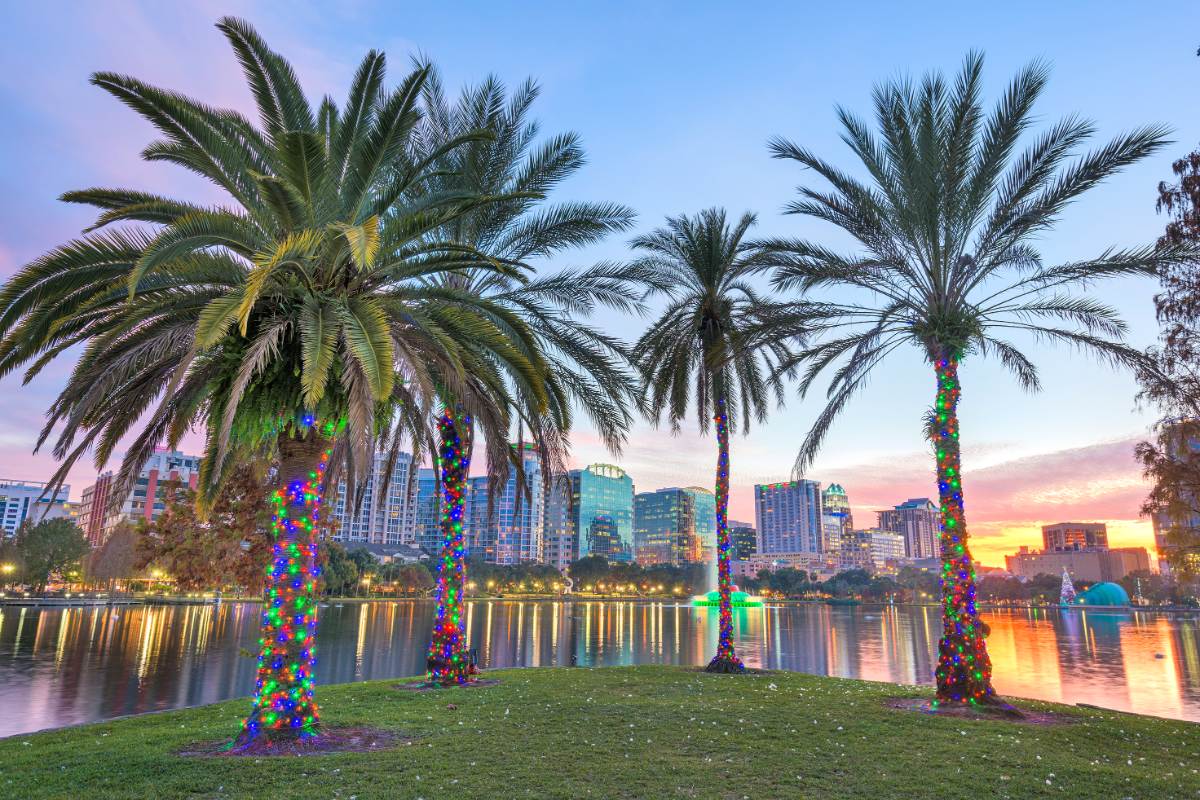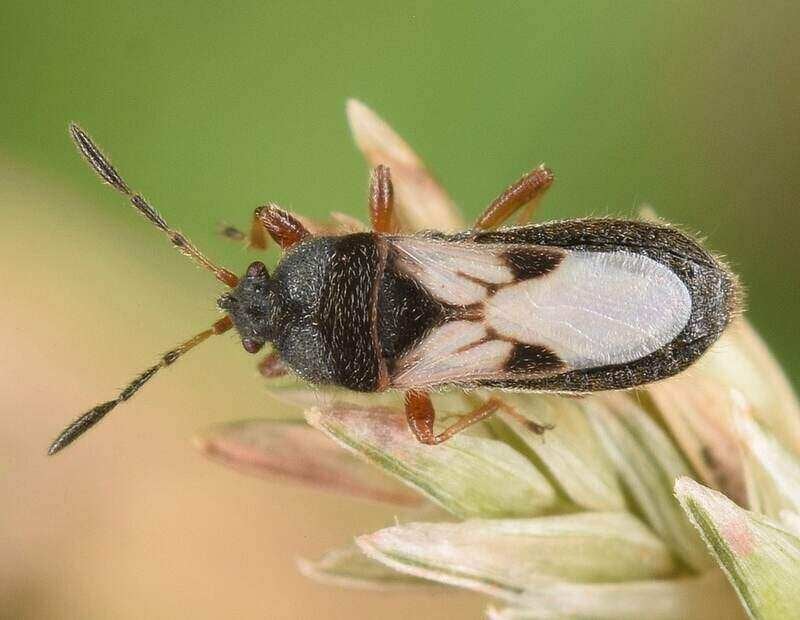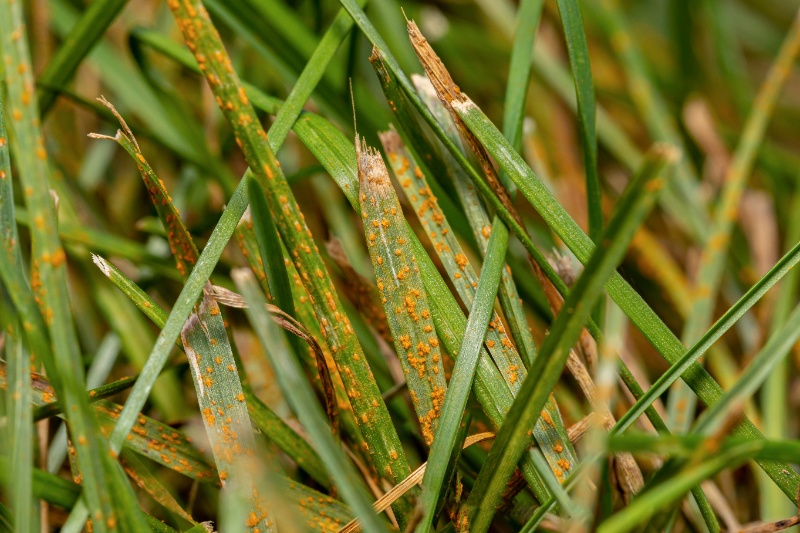
Living in the Orlando area means you can’t just forget about your lawn in the winter. From December to February, you’ll still need to mow periodically, water, and watch for pests and diseases.
Plus, it’s the ideal time to tackle local weeds. We’ve gathered the best winter lawn care tips for Orlando homeowners, including local restrictions and expert advice to help you prepare your lawn for spring like a pro.
- 1. Keep the Lawn Clean (December-February)
- 2. Stop Weeds From Sprouting (Mid-December, Mid-February)
- 3. Watch Out for Lawn Pests (December-February)
- 4. Attack Lawn Diseases (December-February)
- 5. Water Once Every 1-2 Weeks (December-February)
- 6. Protect Your Sprinkler System from Frost (January)
- 7. Mow About Every 3-4 Weeks (December-February)
- 8. Test the Soil (Late January-Mid February)
- 9. Paint the Grass Green (January)
1. Keep the Lawn Clean (December-February)
Piles of debris that linger on the lawn can harbor lawn diseases and pests, including chinch bugs, snakes, and rodents, so keep the lawn neat and clean throughout the cold season.
- Remove twigs and sticks.
- Rake fallen leaves or mulch-mow them to speed up decomposition.
- Bag debris and put it out for yard waste pickup.
If you live in Orange, Osceola, or Lake County, remember that plastic bags are no longer allowed for yard waste. Either put the debris directly in the dedicated container or use paper bags. In Seminole County, paper bags are “strongly preferred.”
Note: Have a live oak shading your yard? Get your leaf blower ready by late February when they start the annual “leaf exchange” and shed their foliage for weeks in a row.
See Related:
2. Stop Weeds From Sprouting (Mid-December, Mid-February)

Winter is a good time for pre-emergent applications:
- In mid-December, make the second treatment for winter weeds to keep the lawn protected until late spring (with a first application in mid-October to early November).
- Late January to mid-February (before day temperatures reach 65 F to 70 F for 4 or 5 days), apply a pre-emergent to stop warm-season weeds from sprouting.
| Month | Type of Treatment | Targeted Weeds |
| Mid-December | Second pre-emergent application for winter weeds | Henbit, annual bluegrass, wild geranium, chickweed, lawn burweed |
| Late January to mid-February | First pre-emergent application for warm-season weeds | Crabgrass, dollarweed, buttonweed, chamberbitter, spotted spurge, Florida pusley |
Examples of pre-emergent herbicides to use: prodiamine (Barricade), dithiopyr (Dimension), and pendimethalin (Pendulum).
Even with fall treatments, some weeds might sprout on your lawn. Hand-pull if just a few or treat with a selective post-emergent herbicide during mild days when temperatures stay above 60 F.
Note: Don’t treat the lawn with post-emergent herbicides when night temps are under 40 F and day temps are under 55 F. Weeds are dormant and won’t absorb the chemicals properly.
Non-selective herbicides, like glyphosate, can harm the turf if you spray them on non-dormant grass. If you need to spot-treat stubborn weeds with such a product, consider a professional application to ensure you don’t damage the turf.
| For safe and effective lawn treatments, hire a LawnStarter weed control pro. Our pros charge an average of $103 per lawn treatment and have a 4.4-star rating with over 39,500 treatments done last year. |
See Related:
- How to Prevent Weeds from Growing in Your Lawn
- How to Get Rid of Weeds in Grass
- How to Remove Weeds From Gravel (7 Methods)
3. Watch Out for Lawn Pests (December-February)

Orlando’s mild winter means the local lawn pests, like chinch bugs, billbugs, sod webworms, grubs, fire ants, and mole crickets, can stay active even in the winter.
They’ll do less damage and be harder to spot, so check your winter lawn carefully during warm spells. Focus on the sunny areas; during winter, pests will look for warmer spots.
If you see signs of pest damage, mix 2-4 tbsp of dish soap with 1 gallon of water and pour on a square yard of lawn, including damaged areas. Any pests hidden in the soil will surface, making identification easy.
Apply an insecticide to the affected areas. Use organic products to limit soil pollution.
While the main pest control window is in early spring, winter is a good opportunity to reduce the pest population. It also gives you the chance to identify the pests in your lawn and decide on the best pest control products for the March application.
See Related:
- How to Get Rid of Chinch Bugs on the Lawn
- How to Get Rid of Sod Webworms
- Lawn Grubs: How and When to Kill Them
- How to Get Rid of Mole Crickets in Your Lawn
4. Attack Lawn Diseases (December-February)

Orlando’s winters are cold enough to slow down grass growth and compromise their defense system, but warm enough to allow fungal diseases to thrive and spread, so keep an eye out for signs of disease.
The most common lawn diseases to watch for in Central Florida are:
- Large patch: Active from mid/late November through May
- Gray leaf spot: Can still be active through December (most damaging in St. Augustine)
- Leaf spot: Active as long as temperatures stay above freezing (most damaging on Bermuda)
- Rust: Active from mid/late November through May
- Dollar spot: A spring and fall disease that can persist in the winter
If you notice signs of disease (patches of dead grass, powdery coating, wilted grass, etc.), collect a sample and take it to the local county Extension office for identification. If it’s a fungal disease, they’ll advise you on what treatments to apply.
Some grasses are more susceptible to certain diseases. Here are the most common grasses in Orlando lawns and the diseases they’re most vulnerable to:
| Type of Grass | Common Diseases in Winter |
| St. Augustine | Large patch, rust, grey leaf spot, dollar spot |
| Bahia | Dollar spot |
| Zoysia | Large patch, leaf spot, dollar spot, rust |
| Bermuda | Large patch, leaf spot, dollar spot |
| Centipede | Large patch, leaf spot, dollar spot |
5. Water Once Every 1-2 Weeks (December-February)
With rainfall ranging from 2.5 to 2.8 inches a month, winter in Orlando is considered a dry season and a nice break from the humidity. Should you water the lawn more? Not at all. The cold weather slows down growth and reduces evaporation, so your grass needs less water.
Water every 1-2 weeks and ensure 1/4 to 1/2 inch of water per week, depending on the weather.
Ensure your sprinkler system covers the entire lawn uniformly to avoid waterlogged areas and dry spots, advise Hannah Eason and Calvin Gardner, Orange County UF/IFAS Extension specialists.
“Poorly calibrated irrigation systems can lead to challenges, so calibrate in the winter so your lawn gets good head-to-head irrigation coverage during the dry season,” add the experts.
Never irrigate when temperatures drop close to 40 F, or you’ll expose the grass to freezing damage.
The best time to irrigate Orlando lawns in winter is in the morning to ensure the grass dries out before nightfall. Central Florida experiences only a handful of nights when it can reach freezing temperatures, but it’s enough to cause freezing damage.
See Related:
- How Often Should You Water Your Lawn in the Winter in Florida?
- Restrictions and Tips for Watering Your Orlando Lawn
- 10 Signs of Overwatering Your Lawn
- 8 Signs Your Lawn Needs Watering
- Keep Your Grass Healthy with a Lawn Sprinkler Audit
6. Protect Your Sprinkler System from Frost (January)
January and February are Central Florida’s coldest months, when temperatures can drop below 32 degrees. Although there are typically only a handful of nights with freezing temperatures, it’s enough to damage your irrigation system if it’s filled with water.
To prevent freezing damage, turn off and drain the sprinkler system between waterings until late February.
See Related:
7. Mow About Every 3-4 Weeks (December-February)

Depending on the year, your Orlando lawn might go dormant and brown in the winter or stay green but grow so slowly you can barely notice. Either way, you’ll mow less than during the growing season.
“Mow sparingly every 3 to 4 weeks, just enough to keep grass tidy. Raise mower height to 3-4 to protect roots and suppress weeds,” says Orlando LawnStarter pro Vicente Vazquez of Cutting Edge Professional Landscaping.
Here are the standard mowing heights for the grasses in Orlando lawns. During winter, mow the grass closer to the maximum recommended height:
| Type of Grass | Optimal Mowing Height (Inches) |
| St. Augustine | 3.0 – 4.0 |
| Bahia | 3.0 – 4.0 |
| Zoysia | 1.0 – 2.0 |
| Bermuda | 0.5 – 1.5 |
| Centipede | 1.5 – 2.0 |
Don’t mow during a freeze. Enjoy a hot chocolate and let the mower rest in the tool shed. Cold fronts visiting the I-4 corridor don’t stay long, and the weather will be warm enough for mowing in a couple of days.
| Take a break and leave mowing to professionals. LawnStarter pros charge an average of $51 for a 1/4-acre lawn and have a 4.5-star rating. |
See Related:
8. Test the Soil (Late January-Mid February)
Test the soil late January to mid-February to ensure you receive the results well before spring fertilization. Here’s what to check particularly for Central Florida soils:
- Phosphorus levels. They are typically high in Central Florida soils, but deficiencies still occur in some lawns.
- Potassium and micronutrients. Most Orlando lawns have sandy soil with low organic matter (around 1%) that doesn’t retain water and nutrients well. Potassium and micronutrient deficiencies are common.
- Soil pH. The average is 6.0 – 7.5 in the Orlando area, but individual properties vary significantly. Your soil could be too acidic or alkaline, which could compromise nutrient absorption.
Bring your soil sample to the local Extension Office or send it directly to the UF/IFAS Extension Soil Testing Laboratory in Gainesville.
See Related:
- How to Read a Soil Test Report
- How Soil pH Affects Lawn Health
- 6 Different Nitrogen Sources for the Lawn
- 5 Tell-Tale Signs Your Lawn Needs Fertilizer
9. Paint the Grass Green (January)
Some Orlando homeowners opt for painting the grass green during the short period when warm-season lawns go dormant and turn brown. In the Orlando area, that’s usually in January and February.
You can buy turfgrass paint and do this DIY, or hire a landscaping pro to do it for you — professionals usually have better products.
See Related: What is Grass Paint and How to Paint Your Lawn
Read Next:
Leave Winter Lawn Care to the Experts

Winter lawn care in Orlando includes mowing, watering, pest monitoring, and disease and weed control — tasks that demand local expertise and precise timing.
Don’t let winter damage set your lawn back. Hire an Orlando LawnStarter pro to take care of your lawn and ensure it thrives come spring.
Managing a lawn in Winter Park, Kissimmee, Apopka, or Altamonte Springs? LawnStarter has pros across the Orlando metro area to help keep your lawn healthy and thriving.
Sources:
- Calvin Gardner, urban horticulture extension agent at the University of Florida, Orange County Extension, Orlando, FL. Personal interview.
- Hannah Eason, commercial horticulture extension agent at the University of Florida, Orange County Extension, Orlando, FL. Personal interview.
- “Your Florida Lawn in Winter – UF/IFAS Extension Gardening Solutions.” University of Florida.
- “Operation of Residential Irrigation Timers.” By irrigation and horticulture specialists Michael D. Dukes, Bernard Cardenas, and Dorota Z. Haman. University of Florida.
- “Winter Freeze Precautions for Orange County Residents.” By Jamie Floer, senior public relations specialist for Orange County Utilities. Orange County.
Main Image: Lake Eola in Orlando in winter. Photo Credit: SeanPavonePhoto / Adobe Stock